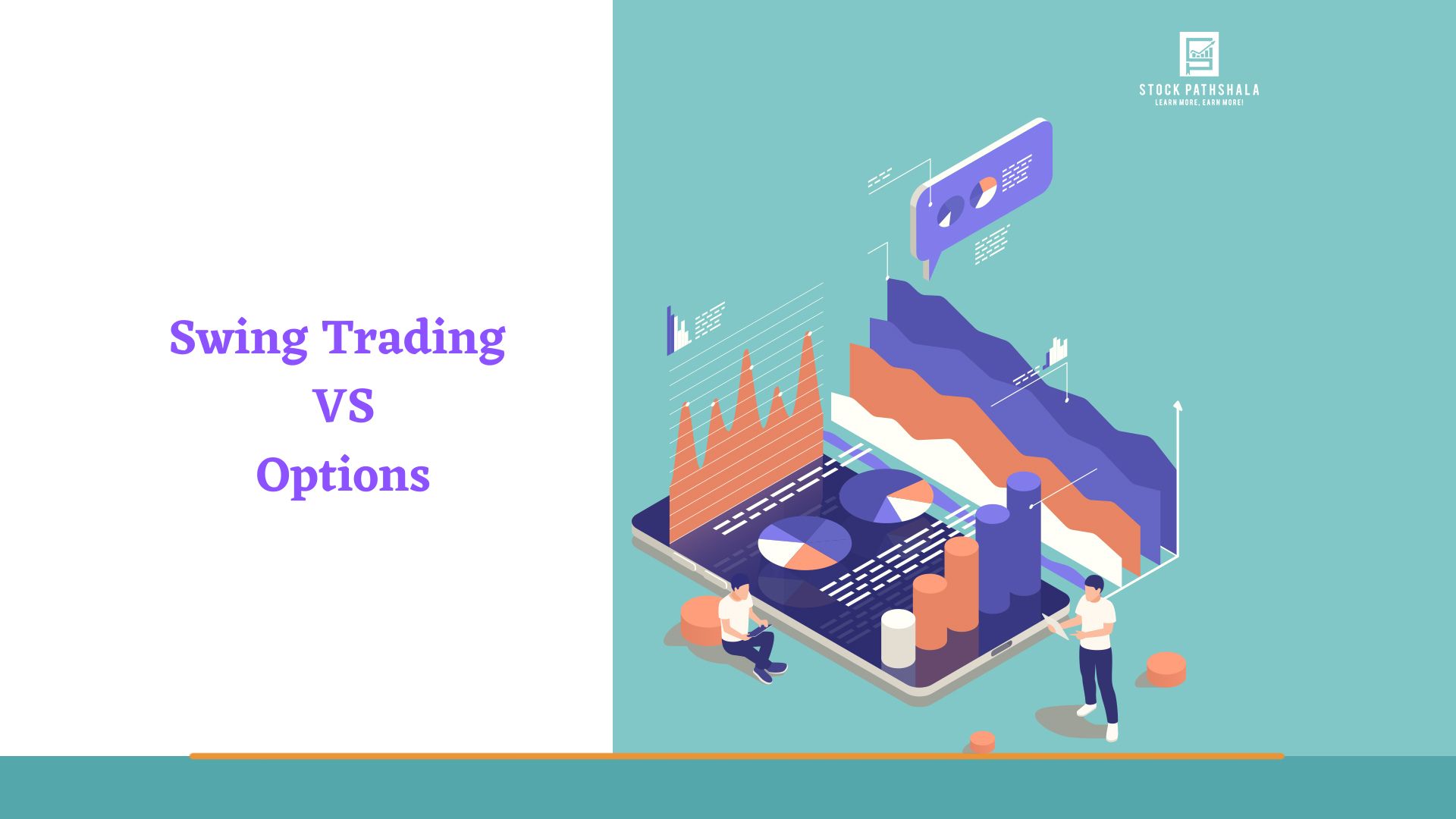Trading is new for you and you have just heard about Swing and options trading. You might be wondering what is the difference between options and swing. Which one is beneficial for you? Here is a complete guide on swing trading vs options where you can get an understanding of how these two trading formats are different from each other.
Let’s explore
Difference Between Swing Trading and Option Trading
In the stock market, trading is defined as opening and closing a position for a short time. Now this can be done in the equity market or in the derivatives and again time period of these trades can vary.
Again the trades differ from each other in terms of risk and reward.
In all, swing and options trading can be compared with respect to their:
- Meaning
- Risk
- Reward
- Capital Requirement
- Holding Period
What is Swing trading?
Swing trading is a short-term delivery trade done in the equity segment where the trader buys and holds shares for the maximum period of 1 month. Here the trader considers the short-term volatility to earn profit.
Let’s consider a hypothetical scenario to illustrate swing trading.
Suppose ABC company is about to announce its quarterly results. Now such results increase the volatility in the market for a few weeks. Seeing this you also decided to hold an open position in the market by analyzing the short-term support and resistance level using the daily chart time frame.
You can buy as many shares as you want depending on the risk and the reward you want to generate from your position.
Also, it comes with flexibility, that means if the stock is moving in an upward direction as per your expectation but does not touch your target within the given time of 4 weeks then on the basis of some more parameters you can choose to hold that stock for as much time as you want.
In order to avoid losses, you can also determine the stop loss and exit the trade if the market goes south.
What is Options trading?
To understand swing trading vs options, let’s now understand what options trading is.
Options trading is a derivative trading strategy that involves buying or selling options contracts on underlying assets. The contracts give the right, but not the obligation, to buy or sell the asset at a predetermined price within a specified period.
Unlike swing trading where you can trade only when the market is expected to move in an upward direction, options trading provides an opportunity to take a trade position in both bullish and bearish market conditions.
The bullish trader can choose either to buy a call or sell a put and similarly bearish trader can choose to sell a call or buy a put.
Here, to give you the context, the option buyer needs capital equal to the premium amount, on the other hand, the seller has to maintain an option trading margin in the trading account to open a selling position.
The option buyer has the right to execute the trade if the market expires in-the-money and earns a profit equal to the intrinsic value of options.
On the other hand, the option seller keeps the whole premium if the market expires out-of-the-money.
To understand this, let’s take the example of Reliance Industries Limited (RIL).
- Current stock price: ₹2,000 per share
- Option type: Call Option (gives the holder the right to buy the stock)
- Option expiration: One month from now
- Strike price: ₹2,100 per share
- Premium= ₹70
Let’s consider two cases:
Case 1: Stock Expires at ₹2300
Intrinsic Value of Call Option = Spot Price – Strike Price
= 2300 – 2100
=200
Here the intrinsic value is positive hence option expires in-the-money, thus the option buyer earns profit equals to ₹200.
Net profit = Profit – Premium
= 200-70
= ₹130
Case 2: Stock Expires at ₹1900
Intrinsic Value of Call Option = Spot Price – Strike Price
= 1900 – 2100
=-200~0
In this case, the intrinsic value is negative hence 0, which means that the option expires out-of-the-money. Thus, the option buyer loses the money equal to the premium amount and the option seller earns a profit equal to ₹70
Other than this the option seller earns profit from time decay in options where the premium loses its value as it approaches expiry.
Which is More Profitable Options or Swing Trading?
Swing trading is a short-term trade, however, you can hold your position until your target is hit in the bullish market. Here with the help of stop loss, you can minimize the loss of your capital.
On the other hand, options trading comes with an expiry. Expiry in share market is the day when the buyer can lose the entire premium value if the market closes out of the money.
Here are some more features on the basis of which one can differentiate between swing and option trading.
- Market Focus: Swing trading focuses on stocks, forex, and commodities, and in Options trading, you trade options based on stocks, forex, commodities, and indices.
- Capital Requirement: In option trading, you need to pay the premium amount and trade in lots which could sometimes be more expensive than swing trading where you can trade depending on the capital you have. Also, for option selling one need a huge capital in order to gain a good profit.
- Flexibility and Time Commitment: In swing trading, there is more flexibility and freedom in choosing your entry and exit points but on the other side, options have different strategies. In both options and swing, you need regular monitoring of price movements and market conditions, but the add-on in options is that you have to keep an eye on the expiration dates as well.
- Leveraged Trading: Swing trading is not inherently leveraged, while Options offer leverage through options contracts.
- Volatility: Where Swing trading takes advantage of short-term price fluctuations, options can benefit from both high and low volatility periods. It depends on whether you are an option seller or an option buyer. A buyer earns profit in the directional and volatile market while sellers generally look for the range and low volatility to earn profit. Apart from historical volatility option traders also look for IV in the option chain that tells them about the future fluctuation in the market.
- Strategies: The most useful and common strategies used for Swing trading are Technical analysis, chart patterns, and different types of technical indicators. Options trading strategies like covered calls, spreads, etc. can help you mitigate the risk.
Swing Trading vs Options Aspect Swing Trading Options Trading Time Horizon Short to medium-term (days to weeks) Short-term (hours to days) Risk Level Moderate risk Higher risk due to leverage Capital Requirement Requires more capital to start Requires less capital to start buying Profit Potential Lower potential compared to options trading Higher potential for significant Complexity Simpler analysis and strategies Complex strategies and pricing models Holding Period Positions can be held longer if profitable Options have an expiration date Flexibility Limited flexibility due to longer holding Provides flexibility in trading Execution Time Longer execution due to analysis Quick execution due to time-sensitive Monitoring Periodic monitoring and adjustments Requires continuous monitoring Market Trend Primarily focuses on trending markets Can trade in any market conditions Tools Needed Charting software and trading platforms Advanced options trading platforms
Conclusion
So according to the above data on swing trading vs options, it is clear that both trades have their pros and cons. If you are a beginning investor, we would suggest you not go directly into options trading, as Options trading is riskier than Swing trading, even though it has unlimited profit potential.
For the start, you can learn about swing trading time frames and how you can gain profit from multiple strategies. We at Stock Pathshala provide advanced level Stock market courses to help trading enthusiasts in a better way.
In case you’d like us to call you back to explain more about stock market learning, just leave your contact info below:
Before investing capital, invest your time in learning Stock Market.
Fill in the basic details below and a callback will be arranged for more information:









